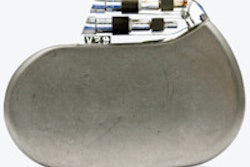
In August 2013, the European Society of Cardiology (ESC) published new guidelines on cardiac pacing and cardiac resynchronization therapy (European Heart Journal, 1 August 2013, Vol. 34:29, pp. 2281-2329). The recommendations contain a section about MRI for pacemaker patients, but caution is still needed because the guidelines are incomplete in this area, according to Dr. Jörg Barkhausen, chair of the German Radiology Society's (DRG) Cardiac & Vascular Diagnostics Working Group and professor of radiology at Lübeck University Clinic.
The following is an interview by the German Radiology Society with Barkhausen.
German Radiology Society: The ESC guidelines dedicate two pages to MRI for pacemaker patients, from page 2322 onward. Do you feel that this is enough?
 Dr. Jörg Barkhausen is chair of the Cardiac & Vascular Diagnostics Working Group at the German Radiology Society.
Dr. Jörg Barkhausen is chair of the Cardiac & Vascular Diagnostics Working Group at the German Radiology Society.
Barkhausen: The general maxim is that any pacemaker patient can undergo MRI, but this really does not do justice to the complexity of the procedure. Even pacemakers that are suitable for MRI are subject to serious limitations, relating to scanning parameters and to areas of the body, and these aspects must, obviously, be taken into account for all other types of pacemaker as well. It does make a difference whether you want to scan a patient's chest or ankle and whether you are using just spin echo techniques or ultrafast MR sequences. There is no clear guidance regarding these matters. The ESC guidelines may well be complete so far as pacemakers are concerned, but they are not where MRI is concerned.
What is your advice to your specialist colleagues?
A check must be made to ensure that there is a solid indication for the examination. Is there an urgent need for an MR exam to resolve the diagnostic issue? What region of the body does this involve? In cases where pacemakers are MRI-compatible, the small print in the information provided by the manufacturer must be read and the best possible scanning parameters must be agreed with an expert in MR physics.
Obviously, care must be taken to ensure that the patient is kept on a monitor during the exam, and the pacemaker will need to be checked by an experienced cardiologist immediately afterward. However, the radiologist must be aware that responsibility for the scan rests with him or her -- not with the person who referred the patient, not with the cardiologist, and definitely not with the pacemaker manufacturer.
What is likely to happen next?
At present, we are in discussions with colleagues from the German Cardiology Society's Magnetic Resonance in Cardiology Working Group. The aim of this is to draft a comprehensive and jointly agreed paper that deals with these issues. That said, even this won't be a carte blanche. It will still be left to the radiologist to decide which pacemaker patients he or she will put through an MR exam, and this will still be his or her responsibility.
Editor's Note: This article is an edited version of a translation of an interview carried out in German and published online on 10 October 2013 by the German Radiology Society (DRG, Deutsche Röntgengesellschaft e.V.). Translation by Syntacta Translation & Interpreting.



















